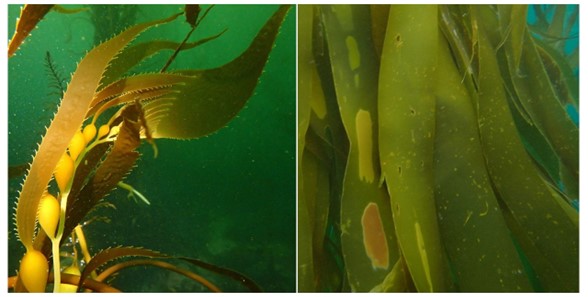 Left: Juvenile giant kelp (Macrocystis pyrifera). Right: Reproductive portions of bull kelp blades (Nereocystis luetkeana). CDFW photos by K. Elsmore
Left: Juvenile giant kelp (Macrocystis pyrifera). Right: Reproductive portions of bull kelp blades (Nereocystis luetkeana). CDFW photos by K. Elsmore
Overview
The California Department of Fish and Wildlife, in partnership with the California Ocean Protection Council, is developing a statewide, ecosystem-based, adaptive Kelp Restoration and Management Plan (KRMP) for giant kelp, Macrocystis pyrifera, and bull kelp, Nereocystis luetkeana. The KRMP will include a cohesive kelp management strategy (PDF)(opens in new tab) which consists of three core components:
- a harvest management framework and other Fishery Management Plan (FMP) elements required by the Marine Life Management Act (MLMA),
- an innovative framework for ecosystem-based management (EBM) of kelp forests and
- a Restoration Toolkit.
The integration of EBM approaches and a Restoration Toolkit into the traditional FMP framework will facilitate a robust, adaptive, climate-ready approach to managing the State’s kelp forest ecosystems in the face of changing ocean conditions.
KRMP Development Process:
A multi-pronged approach (PDF)(opens in new tab), consisting of a Community Working Group(opens in new tab), Science Advisory Committee, and Tribal Engagement, has been implemented to ensure the development of the KRMP is informed by the best available science and community perspectives across the state of California .
The Community Working Group (CWG) is an informal advisory body composed of California Native American tribes, stakeholders, and interested members of the public established to help inform the design and development of the KRMP. The goals of the Community Working Group are to advise on and inform the development of the core components of the KRMP. CWG members are tasked with sharing information about the KRMP development with their broader community networks, as well as tasked with gathering and sharing their communities’ perspectives, interests, and feedback.
The Science Advisory Committee (SAC) is an independent body tasked with providing scientific expertise on all aspects of the KRMP to ensure the best available and most current science is directly integrated into the KRMP. The SAC is composed of experts in natural and social sciences, economics, and local and traditional knowledges, spanning a broad scope of disciplines and geographic areas.
Pathways for Tribal Engagement throughout the development of the KRMP include Tribal Roundtable Listening Sessions, government-to-government consultation, representation on the Community Working Group, and representation on the Science Advisory Committee. Additional pathways for engagement may be identified as the KRMP development process unfolds. A top priority for the State of California is to provide California Native American tribes the opportunity to inform the design and development of the KRMP’s process and outcomes, including exploration of co-management pathways, if this is identified as a priority by California Native American tribes.
KRMP Timeline
The KRMP development process is anticipated to occur over the course of three to five years. More details and information will be made available on this website and on the California Fish and Game Commission's website(opens in new tab).
2022
2023